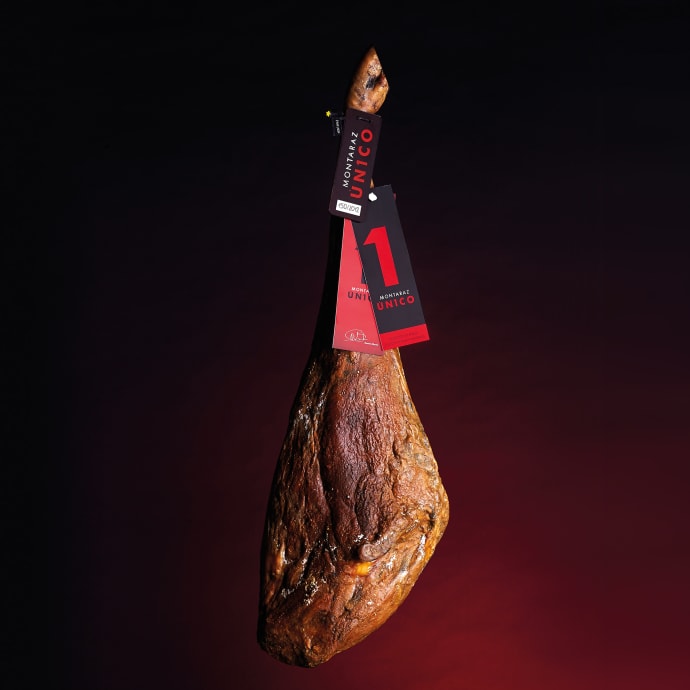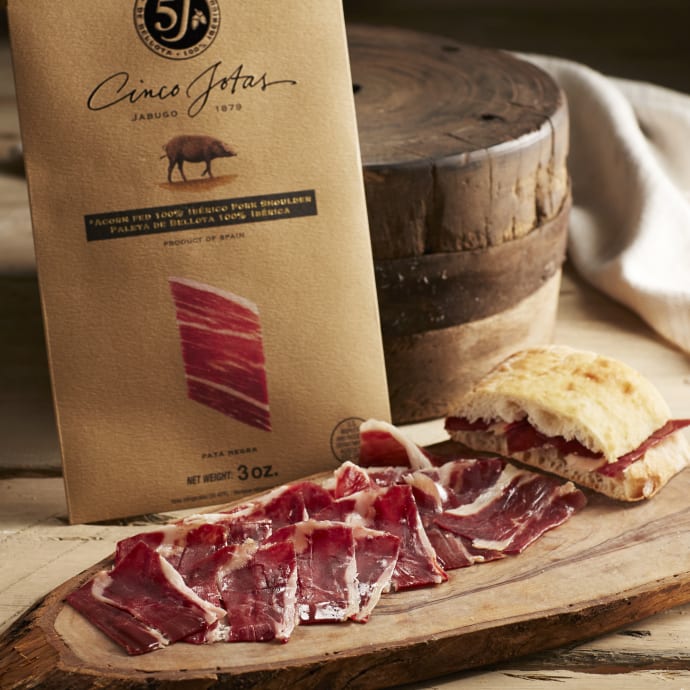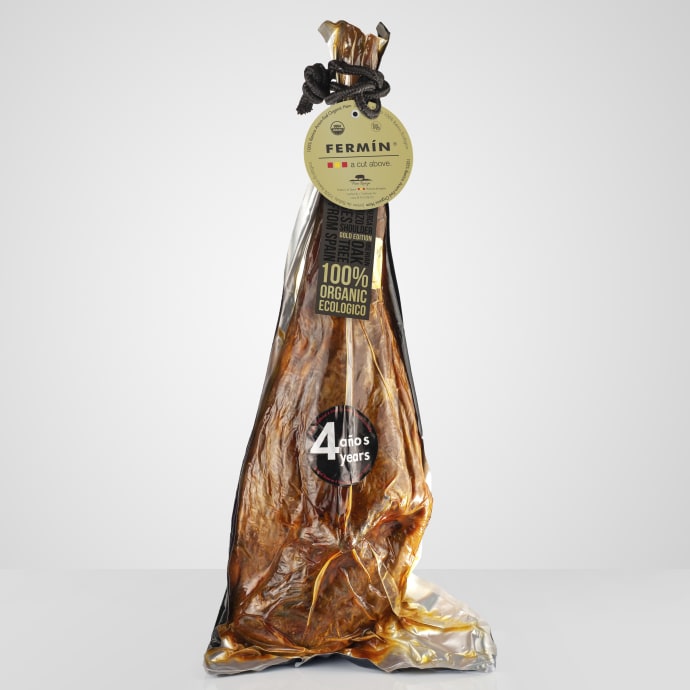
In Spain, a Delicacy Rooted in Earth and Tradition
The New York Times
-
January 17, 2010
On the Trail of Spain's Acorn-Fed Hams
Paola Singer
As we sauntered up the steep, narrow cobblestone streets of Cáceres in western Spain, it wasn’t hard to imagine life there in the Middle Ages. Night was falling, and before us were Gothic churches, Roman arches and Moorish towers, glowing in the soft light of lanterns. It was an arresting sight, but our thoughts soon veered elsewhere — to food and the sumptuous meal we were anticipating.
Most people travel to this ancient city for its architectural treasures; my friends and I had come to eat pork.
Minutes later, we faced an encyclopedic list of traditional dishes at El Figón de Eustaquio, a family restaurant with jacketed waiters and white tablecloths. For starters, we had a plate of jamón Ibérico de bellota — cured ham made from acorn-fed pigs, which is the regional specialty — plus a round torta del casar, a creamy sheep’s milk cheese enveloped in a hard curd, and giant locally grown white asparagus.
Though I considered the herbed pork sirloin as an entree, my friend Joan insisted we order the esoteric-sounding secreto Ibérico, or Iberian secret. This simply presented pork filet, we later learned, comes from a special cut near the front leg that’s interspersed with very thin layers of fat. After making all sorts of silly jokes about the curious name of this dish, we ate in complete silence. It was incredibly tender, subtly seasoned and simply delicious.
Cáceres, in the Extremadura region, is in the heart of Spain’s pig country. I had traveled there in search of the world’s best ham, a recent food obsession instigated by Spanish friends. Along the way, I discovered a variety of mouthwatering specialties, learned about unique traditions and met locals with a contagious passion for their culinary heritage.
As people’s knowledge and love of Spanish cuisine grow, delicacies like jamón Ibérico de bellota are entering the international spotlight. This time-honored ham arrived in the United States in 2008 to much fanfare. Sold for about $200 a pound at specialty stores like LaTienda.com, it became the most expensive cold cut in the country. Discerning consumers seem eager to pay this lofty price. This summer, the powerhouse brand 5J (Cinco Jotas) plans to enter the American market, joining the U.S.D.A.-certified producer Embutidos Fermín.
“Iberian pork meat is extraordinary,” Ferran Adrià, the acclaimed chef at El Bulli, a three-Michelin-star restaurant in Catalonia, said in a phone interview. “There’s nothing like it elsewhere in the world. There’s a great difference between a superior ham and all the rest.”
The secret of this superiority rests in the thousands of acres of dehesas — mountainous meadows populated by oak trees — where the indigenous black Iberian pigs have roamed since ancient times. They feed on grass, fruit and, most importantly, acorns that fall every autumn from holm and cork oaks. This gives their meat a unique nutty flavor and a high level of oleic acids, considered a healthy fat.
Spaniards take this food tradition seriously. More than 40 million cured hams were sold last year in Spain, and those derived from Iberian pigs are a particular source of national pride. Local residents started curing meats more than a thousand years ago, eventually turning the craft into an art.
Our sybaritic journey started in Salamanca, 130 miles west of Madrid. This lively city marks the unofficial beginning of the Iberian ham trail, which stretches roughly 300 miles down to Seville. My travel companions — María, an effusive Madrileña who drove expertly over cliff-hanging roads, and Joan, an adventurous Catalan who helped us discover the Iberian secret — were old friends and fellow carnivores.
After a brisk tour of Salamanca’s historic center and its lovely Plaza Mayor, we defied the custom of savoring one’s meals and ordered a few appetizers to go. We had an important appointment 30 miles south, in Guijuelo, a small town of dowdy, low-rise buildings and old-fashioned ham shops. I had arranged to visit several ham producers on our pilgrimage, and this was a required stop: the headquarters of Joselito, considered the Dom Pérignon of hams.
Joselito’s owner, José Gómez, on first impression a laconic man, spoke long and fervently about the 100-year-old empire founded by his great-grandfather. “My customers are not concerned with price; they ask for the best,” he said. “The three key elements are breed, diet and curing.”
While touring the company’s building, I received a master class. Each leg of ham spends about nine days covered in salt; it hangs for weeks in winter temperatures, so the salt penetrates deeply, then for months in summer heat, prompting a “sweating” process by which the fat further permeates the muscle fibers. This happens in cavernous chambers devoid of machinery, where windows are opened or shut depending on winds and humidity. When summer ends, the hams are moved to a dark cellar where they age for two or more years, intensifying their aroma and flavor, much like a fine wine.
Joselito uses only hogs that are 100 percent Iberian. A whole leg, aged three years, starts at $1,000 in Spain, about $50 a pound. (Not all hams called Ibérico are acorn-fed. The label must include the word bellota.) In spite of so much tantalizing talk amid mesmerizing rows of sweet-smelling hams, no amuse-bouche was offered, and we left with empty stomachs. It was only later, savoring our memorable dinner in Cáceres, that we quelled our cravings.
After a good night’s rest at the NH Palacio de Oquendo, a renovated 16th-century palace in the old quarter, we had breakfast alfresco on the edge of the main plaza. Nothing beats a good cortado, the strong Spanish coffee, before a long drive.
The curvy, oak-lined southern roads led us to Jabugo, a village of plain white houses that lives and breathes jamón. There I met Maximiliano Portes, who in 2002 created the online brand Maximiliano Jabugo. His customers, he said, are everyday people who order airtight, pre-sliced cold cuts. Modern marketing notwithstanding, the only way to achieve high quality is through a slow, artisanal curing process. Mr. Portes’s hams hang in a thick-walled cellar, where meat has been cured since 1900. In fact, Jabugo’s quiet cobblestone streets, dotted with modest bars where local workers meet for afternoon drinks, showed no signs of modernity.
As we headed back north to Badajoz, a heavy rain slowed us. By the time we reached Rocamador, a rural hotel and restaurant in a 500-year-old former monastery, it was 11 p.m. and our stomachs were growling. Thanks to the Spanish custom of late dining, the kitchen was still open.
Though I was tempted by pork cheeks in a creamy vegetable sauce, for a change of pace I ordered thyme-seasoned suckling lamb with roasted potatoes. A glass of hearty Extremadura red was the perfect complement. Back in my country-chic room, aided by a lullaby of rattling leaves, I fell into a deep sleep.
In the morning I met Carlos Tristancho, owner of the hotel and surrounding land. He is a partner at País de Quercus, a company that sells organic meats to distinguished restaurants like Mugaritz and El Celler de Can Roca. A former actor, director and producer, Mr. Tristancho is an irrepressible, middle-age character who talks about love, sex and the soul the way most people discuss the weather.
During a rambling and wildly entertaining conversation, he spoke passionately of the importance of preserving Spain’s estimated seven million acres of dehesa. “This is an example of sustainability; some of the oaks here are 1,000 years old,” he said. Ideally, each animal needs six acres to roam, he said; if this balance is not respected, the ecosystem could be in danger
Soon we were headed to Madrid, laughing about how we had blushed at Mr. Tristancho’s bawdy comments. But while our road trip was ending, my food quest persisted. For various reasons, I had not yet sampled a Joselito ham; I knew I could not leave Spain until I had.
A few hours before my flight to New York, I walked to a gourmet shop on upscale Serrano Street. The man behind the counter carefully carved a few slices with a long knife and handed me a bite. He raised his eyebrows inquisitively. A pungent, slightly sweet and nutty flavor filled my mouth as the fat immediately melted away, revealing sea-salted, tender strings of meat. I can still taste it if I close my eyes.
Paola Singer
As we sauntered up the steep, narrow cobblestone streets of Cáceres in western Spain, it wasn’t hard to imagine life there in the Middle Ages. Night was falling, and before us were Gothic churches, Roman arches and Moorish towers, glowing in the soft light of lanterns. It was an arresting sight, but our thoughts soon veered elsewhere — to food and the sumptuous meal we were anticipating.
Most people travel to this ancient city for its architectural treasures; my friends and I had come to eat pork.
Minutes later, we faced an encyclopedic list of traditional dishes at El Figón de Eustaquio, a family restaurant with jacketed waiters and white tablecloths. For starters, we had a plate of jamón Ibérico de bellota — cured ham made from acorn-fed pigs, which is the regional specialty — plus a round torta del casar, a creamy sheep’s milk cheese enveloped in a hard curd, and giant locally grown white asparagus.
Though I considered the herbed pork sirloin as an entree, my friend Joan insisted we order the esoteric-sounding secreto Ibérico, or Iberian secret. This simply presented pork filet, we later learned, comes from a special cut near the front leg that’s interspersed with very thin layers of fat. After making all sorts of silly jokes about the curious name of this dish, we ate in complete silence. It was incredibly tender, subtly seasoned and simply delicious.
Cáceres, in the Extremadura region, is in the heart of Spain’s pig country. I had traveled there in search of the world’s best ham, a recent food obsession instigated by Spanish friends. Along the way, I discovered a variety of mouthwatering specialties, learned about unique traditions and met locals with a contagious passion for their culinary heritage.
As people’s knowledge and love of Spanish cuisine grow, delicacies like jamón Ibérico de bellota are entering the international spotlight. This time-honored ham arrived in the United States in 2008 to much fanfare. Sold for about $200 a pound at specialty stores like LaTienda.com, it became the most expensive cold cut in the country. Discerning consumers seem eager to pay this lofty price. This summer, the powerhouse brand 5J (Cinco Jotas) plans to enter the American market, joining the U.S.D.A.-certified producer Embutidos Fermín.
“Iberian pork meat is extraordinary,” Ferran Adrià, the acclaimed chef at El Bulli, a three-Michelin-star restaurant in Catalonia, said in a phone interview. “There’s nothing like it elsewhere in the world. There’s a great difference between a superior ham and all the rest.”
The secret of this superiority rests in the thousands of acres of dehesas — mountainous meadows populated by oak trees — where the indigenous black Iberian pigs have roamed since ancient times. They feed on grass, fruit and, most importantly, acorns that fall every autumn from holm and cork oaks. This gives their meat a unique nutty flavor and a high level of oleic acids, considered a healthy fat.
Spaniards take this food tradition seriously. More than 40 million cured hams were sold last year in Spain, and those derived from Iberian pigs are a particular source of national pride. Local residents started curing meats more than a thousand years ago, eventually turning the craft into an art.
Our sybaritic journey started in Salamanca, 130 miles west of Madrid. This lively city marks the unofficial beginning of the Iberian ham trail, which stretches roughly 300 miles down to Seville. My travel companions — María, an effusive Madrileña who drove expertly over cliff-hanging roads, and Joan, an adventurous Catalan who helped us discover the Iberian secret — were old friends and fellow carnivores.
After a brisk tour of Salamanca’s historic center and its lovely Plaza Mayor, we defied the custom of savoring one’s meals and ordered a few appetizers to go. We had an important appointment 30 miles south, in Guijuelo, a small town of dowdy, low-rise buildings and old-fashioned ham shops. I had arranged to visit several ham producers on our pilgrimage, and this was a required stop: the headquarters of Joselito, considered the Dom Pérignon of hams.
Joselito’s owner, José Gómez, on first impression a laconic man, spoke long and fervently about the 100-year-old empire founded by his great-grandfather. “My customers are not concerned with price; they ask for the best,” he said. “The three key elements are breed, diet and curing.”
While touring the company’s building, I received a master class. Each leg of ham spends about nine days covered in salt; it hangs for weeks in winter temperatures, so the salt penetrates deeply, then for months in summer heat, prompting a “sweating” process by which the fat further permeates the muscle fibers. This happens in cavernous chambers devoid of machinery, where windows are opened or shut depending on winds and humidity. When summer ends, the hams are moved to a dark cellar where they age for two or more years, intensifying their aroma and flavor, much like a fine wine.
Joselito uses only hogs that are 100 percent Iberian. A whole leg, aged three years, starts at $1,000 in Spain, about $50 a pound. (Not all hams called Ibérico are acorn-fed. The label must include the word bellota.) In spite of so much tantalizing talk amid mesmerizing rows of sweet-smelling hams, no amuse-bouche was offered, and we left with empty stomachs. It was only later, savoring our memorable dinner in Cáceres, that we quelled our cravings.
After a good night’s rest at the NH Palacio de Oquendo, a renovated 16th-century palace in the old quarter, we had breakfast alfresco on the edge of the main plaza. Nothing beats a good cortado, the strong Spanish coffee, before a long drive.
The curvy, oak-lined southern roads led us to Jabugo, a village of plain white houses that lives and breathes jamón. There I met Maximiliano Portes, who in 2002 created the online brand Maximiliano Jabugo. His customers, he said, are everyday people who order airtight, pre-sliced cold cuts. Modern marketing notwithstanding, the only way to achieve high quality is through a slow, artisanal curing process. Mr. Portes’s hams hang in a thick-walled cellar, where meat has been cured since 1900. In fact, Jabugo’s quiet cobblestone streets, dotted with modest bars where local workers meet for afternoon drinks, showed no signs of modernity.
As we headed back north to Badajoz, a heavy rain slowed us. By the time we reached Rocamador, a rural hotel and restaurant in a 500-year-old former monastery, it was 11 p.m. and our stomachs were growling. Thanks to the Spanish custom of late dining, the kitchen was still open.
Though I was tempted by pork cheeks in a creamy vegetable sauce, for a change of pace I ordered thyme-seasoned suckling lamb with roasted potatoes. A glass of hearty Extremadura red was the perfect complement. Back in my country-chic room, aided by a lullaby of rattling leaves, I fell into a deep sleep.
In the morning I met Carlos Tristancho, owner of the hotel and surrounding land. He is a partner at País de Quercus, a company that sells organic meats to distinguished restaurants like Mugaritz and El Celler de Can Roca. A former actor, director and producer, Mr. Tristancho is an irrepressible, middle-age character who talks about love, sex and the soul the way most people discuss the weather.
During a rambling and wildly entertaining conversation, he spoke passionately of the importance of preserving Spain’s estimated seven million acres of dehesa. “This is an example of sustainability; some of the oaks here are 1,000 years old,” he said. Ideally, each animal needs six acres to roam, he said; if this balance is not respected, the ecosystem could be in danger
Soon we were headed to Madrid, laughing about how we had blushed at Mr. Tristancho’s bawdy comments. But while our road trip was ending, my food quest persisted. For various reasons, I had not yet sampled a Joselito ham; I knew I could not leave Spain until I had.
A few hours before my flight to New York, I walked to a gourmet shop on upscale Serrano Street. The man behind the counter carefully carved a few slices with a long knife and handed me a bite. He raised his eyebrows inquisitively. A pungent, slightly sweet and nutty flavor filled my mouth as the fat immediately melted away, revealing sea-salted, tender strings of meat. I can still taste it if I close my eyes.
Other Press
See How Jamón Gets Made in the Heartland of Spanish Pork
Washington Post
-
April 16, 2024
How to Buy Jamón Ibérico: What to Look for and Where to Get It
Food & Wine
-
August 15, 2018
A look inside Spain’s only ham museum — a worthy temple to the country’s most delicious export
Mic
-
August 8, 2017
The Truth About Jamon Iberico
Cigar Aficionado
-
February 1, 2017
Featured Products

Ibérico de Bellota Sliced Jamón - Peregrino
J-JM-52
$39.00$39.00
 SHIPS FREE
SHIPS FREEIbérico de Bellota Bone-In Jamón - Peregrino - FREE SHIPPING!
J-JM-79
$1,099.00$1,099.00
 SHIPS FREE
SHIPS FREE100% Ibérico de Bellota Bone-In Jamón - Cinco Jotas - FREE SHIPPING!
J-JM-106
$1,499.00$1,499.00
 SHIPS FREE
SHIPS FREEIbérico de Bellota Bone-In Ham - Montaraz - FREE SHIPPING!
J-JM-162
$1,199.00$1,199.00

100% Ibérico de Bellota Sliced Shoulder - Cinco Jotas
J-JM-111
$49.00$49.00
 SHIPS FREE
SHIPS FREEJamón Ibérico de Bellota USDA Organic - Fermín - FREE SHIPPING!
J-JM-186
$1,499.00$1,499.00
 SHIPS FREE
SHIPS FREEIbérico de Bellota Bone-In Reserva Jamón - Fermín - FREE SHIPPING!
J-JM-76
$1,450.00$1,450.00







